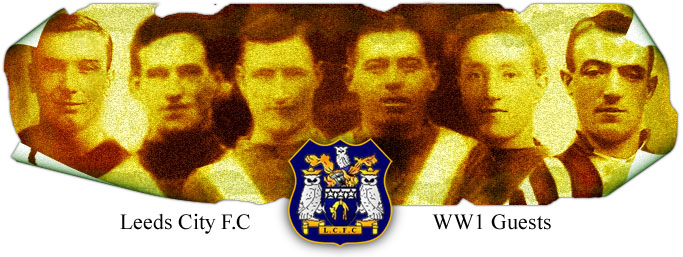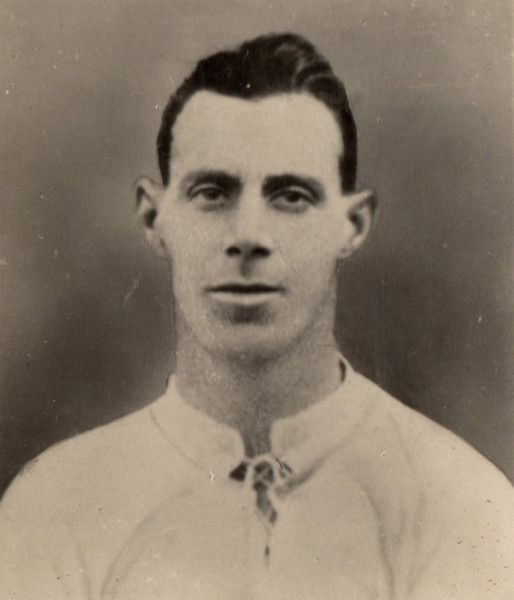

Jennings: William (Bill)
1916-1916 (Leeds City War-time Guest Player Details)
Centre Half
Born: Cinderhill, Derbyshire: 25-02-1891
Debut: v Notts County (a): 21-04-1916
Height & Weight: Unknown
Jennings was brought up in the mining area of Bulwell, just outside Nottingham, alongside his his younger brother Sam, who was almost eight years his junior. Sam
was a striker who knew where the net was, where as Bill was a resolute central defender and started his football career with Rigby Athletic and Arnold St Mary’s before
joining Second Division Notts County in 1913. Whereas the younger brother, Sam, born on 18th December 1898, had started with Highbury Vale Methodists, Basford
United, 5th Reserve Battalion Coldstream Guards and Basford National Ordinance Factory before joining his brother for the only time in their careers at Norwich City in
the 1919-20 season before Sam moved to Middlesborough the following season before making his name with Reading scoring forty-five goals in just 110 games in a
three seasons. He moved to West Ham United for the 1924-25 season, but could only make the first team on nine occasions, and netted three goals. His debut came
on 30th August 1924 in a 1- 0 home win against Preston North End and he was off to a flying start as he scored the only goal in front of a 25,000 crowd. His second
came in his fifth appearance on 18th October 1924 in a 1-2 defeat at Nottingham Forest and his third and final goal for the Hammers on 28th February 1925 in a 4-5
defeat at Turf Moor at the hands of Burnley. He moved to Brighton for the 1925-26 season and found the going much better scoring sixty-one goals in one hundred and
ten League appearances before leaving for Nottingham Forest, where he scored fifteen goals in twenty-seven league games in the 1928-29 season. He picked up his
only medal as Port Vale won the Football League Third Division North in first season in 1929–30, while he was top scorer in both seasons he played for Port Vale
managing forty-two goals in just sixty-three League appearances. He was off to a flying start, scoring both of Vale's goals on his debut on 31st August 1929 over Halifax
Town at The Shay. His first hat-trick came on 8th March 1930 in a 3-0 home win over South Shields. He finished as the club's top scorer for the 1929–30 season with
twenty-seven goals in only thirty-three games. The following season he helped himself to four goals on 22nd September 1930 in an 8-2 demolition of Bradford Park
Avenue at home as he went on to score seventeen goals in thirty-two League games in his second season, as Port Vale achieved fifth place in the Second Division,
which remains as the club's highest League position. He managed to play for three clubs in the 1931-32 season. He hit two goals on the opening day of the 1931–32
season, in a 3–1 win over Plymouth Argyle at Home Park and only played one more game. However, he was soon on his travels again joining Third Division North side
Stockport County in September 1931. He made his debut in a 0-1 defeat at York City on 12th September 1931. The games came thick and fast but unfortunately the
goals did not and the only goals he scored were in a 1-1 draw at Rotherham United in his fourth appearance on 26th September 1931 and his second and final goal
came in the next game on 3rd October 1931 in a 2-0 home win over Hull City. He played his final game for the Hatters on 16th January 1932 in a 0-1 defeat at Southport.
He then made a return to the Second Division, scoring twice in six appearances at Turf Moor. In May 1932 he moved to France where he joined Olympique de Marseille,
and scored four times in fourteen games as Marseilles finished second at the end of the 1932-33 season. Once again he was on his travels as he moved on to Club
Francais of the French League Two for the 1933-34 season before returning to England and played in Non-League with Scarborough in 1934-35 and Wisbech Town in
1935-36 before retiring. He then coached Glentoran in Northern Ireland before returning to England where he coached Rochdale in 1937-38. He fought in the war but
contracted pneumonia twice and had to return to England where he died, aged 45, on 21st August 1944 at Robertsbridge in Sussex. He was buried at Hastings
Crematorium eight days later. So after their careers could have been together at the same club. The brothers' paths divided after just one season together at Norwich
City. Central defender Bill, who started at Notts County, and made his debut on 4th October 1913, in one of the few games they failed to gain a point, going down 0-1
to Clapton Orient at Millfield. He went on to make twenty appearances in their promotion-winning season of 1913-14, when they topped the Second Division with fifty-
three points, four more than second placed Bradford Park Avenue, who were also promoted. In a team that included the tallest player in the League, County goalkeeper
Albert Iremonger, who went on to play five hundred and sixty-four games for County in a remarkable with Notts County. Born at Wilford Nottinghamshire, he made his first
appearance in the County team on 17th April 1904 and was considered indispensible and many times was ever-present. He made the most of his exceptional physical
advantages which come in useful when he had occasion to come out of goal to fist away amidst a crowd of players. He was also a cricketer and invariably spent his
summer coaching young cricketers at one of the public schools. He was certainly a good custodian and commanded the area that Jennings was weakest in. In his early
days he was considered to be of slight physique when he started playing for Notts County before the First World War. Jennings played twenty-two games in the League
as County came sixteenth in the First Division before the Football League fixtures were suspended until after the end of the First World War. His connection to Leeds City
came when Leeds City visited Notts County for a Midland Section game on 21st April 1916. It was to be his only game for them. He made his only appearance, as a guest
for Leeds City, in the unaccustomed role of Outside Left against his own team in the final game of the 1915-16 Principal Tournament, quite likely a goodwill gesture by
Notts County as teams often used to turn up with men short and made up their team as best they could. Jennings, who had arrived expecting to be a spectator, filled the
gap, playing at outside-left in place of Willie Wilson, who was unavailable because of military duties. Five months earlier he had played right-half for County at Elland Road
on 27th November1915 as County proved too good for City and gained a resounding victory by four goals to nil. The game at Meadow Lane produced a keenly fought 1-1
draw with the Leeds Mercury reporting: "The Leeds forwards provided the spectators with some very clever passing, particularly Jennings, who, although playing in a new
position, fully justified himself." After the end of the war, Jennings left Notts County to sign for Norwich City, before the start of the 1919-20 season and there he played one
season with his brother as Norwich came twelfth in the Southern League with forty-one points from forty-two games and only reached the first round in the F.A. Cup. The
following season, Norwich and the rest of the Southern League became the Third Division of the Football League but Jennings decided to move to Merthyr Town before the
start of the 1920-21 season as they would both be part of that League for the 1920-21 season. He missed only one match for the Welsh team in their inaugural Football
League season and made his debut against Crystal Palace in their inaugural fixture when 16,937 spectators turned up to Penydarren Park to see the home side defeat the
Londoners by three goals to one. Merthyr's first season saw them attain their highest League standing, when they finished eighth in the Third Division. He stayed with the
club for two seasons, scoring three goals in seventy league appearances for the Welsh side. He then moved to Luton Town in the summer of 1922. He scored twice in one
hundred and fourteen League games for The Hatters, but lost his place in December 1925 and moved to Northampton Town the following summer. However, he only
managed three appearances for The Cobblers in the autumn of 1926 before moving to Non-League Peterborough & Fletton United. After his spell in Non-League he left for
Canada to end his career with Hearts of Winnipeg. He died in 1953, aged sixty-two.
| War-time Guest Appearances | Goals |
| |
| Principal Tournament 1 | 0 |
| Subsidiary Tournament 0 | 0 |
| Total 1 | 0 |